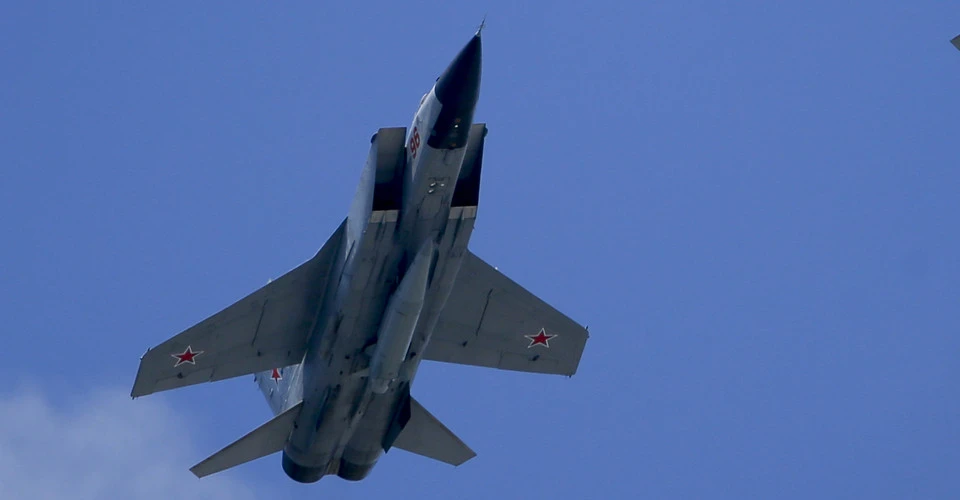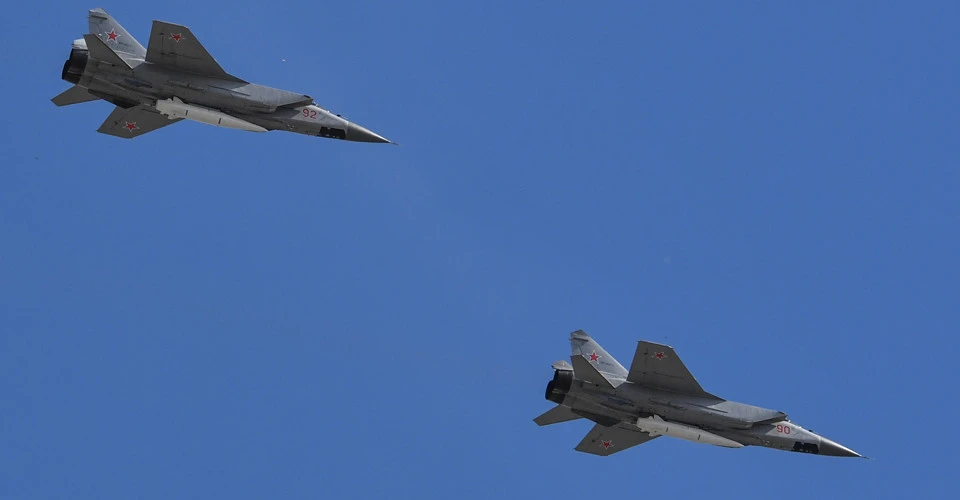
MiG-31 fighter: aircraft’s dange to Ukrainians and its characteristics
Ukrainians hear about this aircraft almost daily. Every time a Russian MiG-31 takes off, an air raid alert is announced across Ukraine
Espreso shares the features of this fighter jet, the threat posed by MiGs and how to deal with them.
The MiG-31 was the first Soviet 4th generation fighter jet. Initially, it was designed to intercept cruise missiles and other sophisticated airborne targets. The aircraft has outstanding characteristics: speed of up to 3,400 km/h, ceiling of 20 km, range of 720 km, weight of 46.75 tonnes. Various modifications of the MiG-31 have been used as carriers of advanced weapons and even to launch satellites into orbit.
What is MiG-31?
The MiG-31 is a Soviet two-seat supersonic long-range fighter interceptor. While previous interceptors in the USSR worked in close cooperation with ground-based targeting stations (up to intercepting on commands from the control center), the MiG-31st was designed to perform an autonomous combat mission. The fighter jet entered service in 1981.
MiG-31 is one of the few production aircraft to ever reach supersonic cruise speed without the use of afterburners and a maximum speed of Mach 2.85. The fighter was intended to protect the territory of the USSR from cruise missile attacks from the Arctic, where there was no continuous radar field. In general, the MiG-31 was designed for long-range patrols and the destruction of high-altitude targets. Its range of about 1,450 km makes it the main guardian of the Russian Arctic and the Far East. They are used as carriers of advanced weapons or even to launch satellites into orbit.
The MiG-31 is based on the MiG-25 single-seat aircraft, the world's first production fighter with a speed of over 3,000 km/h. To improve its low-altitude performance, the MiG-31's structure was strengthened, and the aircraft became a two-seater, with a navigator-operator in addition to the pilot.

Photo: gettyimages
Modifications and features of MiG-31
Over 40 years, the aircraft has undergone eight modifications and upgrades. There are 13 different modifications of the MiG-31. Here are some of them:
The MiG-31B is a production version equipped with an air-to-air refueling system, which entered service in 1990.
The MiG-31BM is an upgraded aircraft that received a new weapon control system and radar system that can detect targets at a distance of up to 320 km and simultaneously track up to ten airborne targets.
The MiG-31I is an aircraft designed for air launch of small spacecraft weighing 120-160 kg.
The MiG-31F is a multirole frontline fighter designed to attack ground targets.
The MiG-31K is a modification with the ability to mount the Kinzhal missile (letter K).
The airframe is made of all-metal construction. High-strength steels account for 50% of the weight, and titanium alloys for 16%. The main landing gear supports of the MiG-31 have an unusual configuration. The front wheel is shifted inwards from the longitudinal axis of the main landing gear, while the rear wheel is shifted outwards. This improves cross-country ability on unpaved and icy landing strips.
The fighter is equipped with infrared and radar electronic warfare devices. The MiG-31 performs its missions with the support of a ground-based digital control system. The automated ground system can coordinate four aircraft simultaneously if the distance between them does not exceed 200 km.
Without missiles, the MiG-31 has a flight range of 2,480 km (duration 2 hours 44 minutes). With 4 missiles, the range is 2,400 km and the flight duration is 2 hours 35 minutes.
Tactical and technical characteristics of MiG-31
- Crew - 2 people,
- Length - 22.7 m,
- Wingspan - 13.5 m,
- Empty weight - 21.8 tonnes,
- Fully refueled weight - 39.15 tonnes,
- Maximum take-off weight - 46.75 tonnes,
- Maximum speed - 3,100 km/h at high altitude and 1,500 km/h at low altitude,
- Cruising speed - subsonic 900 km/h, supersonic 2,500-2,800 km/h,
- Range without refueling - 3,000 km,
- Combat radius - 720 km,
Why does the air raid alarm sound when a MiG-31 takes off?
It is the MiG-31 that constantly appears in reports when it comes to air raid alerts across Ukraine.
The General Staff explained that the fact is that a Russian MiG-31K takes off almost every day. It is this modification that carries the Kinzhal hypersonic missiles (Kh-47), which can reach targets throughout Ukraine.
Since last autumn, MiG-31Ks have also been stationed at airfields in Belarus. At the same time, British intelligence provided evidence of Russian deployment of Kinzhal missiles in Belarus. Each of these missiles weighs more than 4 tonnes, with a warhead weight of about 500 kg. The maximum range when launched from a MiG is 2,000 kilometers.
Russians are widely using Kinzhal for air attacks. For example, on 9 March, a massive attack on ten regions of Ukraine resulted in deaths and injuries, and damage to critical infrastructure. The aggressors used 6 Kinzhal missiles in the night attack. The same number was used during another massive missile attack in May. Back then, Kh-47 aeroballistic missiles were fired from six MiG-31K aircraft, and all of them were shot down by Ukrainian air defense.
"The destruction of the six Kinzhal missiles is a unique event for both the developers of the Patriot system and our military. Patriot has confirmed the ability to combat group attacks by hypersonic missiles, and our calculations have shown that they can operate effectively in such difficult and extreme conditions," military expert Serhiy Zgurets wrote at the time. At the same time, it should be understood that not all Ukrainian cities have such a powerful air defense system as the capital, so any take-off of a MiG-31 with missiles that can hit at 2,000 km poses a great threat.
In general, the Air Force says that Russia often takes MiG-31s into the sky to test Ukrainian air defenses, train its aircrew and influence the psychological state of Ukrainians.
"First of all, the flights are still related to the training of the aircrew, to the launch areas, and thus, the training of pilots is a continuous process, and it always goes on, and even more so in the conditions of hostilities, they train them. In addition, air raids, which constantly annoy people in Ukraine, affect our economy and our psychological state, the enemy understands this perfectly well," said Air Force spokesman Yuriy Ihnat.
In addition, Defense Express notes that the MiG-31 is a rather dangerous machine even as a conventional interceptor due to the presence of powerful radar equipment and ultra-high-range air-to-air missiles. In particular, the onboard radar allows the aircraft to be used to detect air targets at ranges of hundreds of kilometers.
How many MiG-31s does Russia have and how to deal with them
At the beginning of 2021, the Russian Air Force had about 1,500 aircraft, of which MiG-31s accounted for about 8% (131 aircraft). Production of the 31s ended back in 1994. These aircraft are being upgraded to MiG-31BM or MiG-31K variants, but most of them have been in service for over 30 years and their service life has been exhausted.

Photo: gettyimages
These aircraft are potentially to be replaced by the MiG-41. The next-generation aircraft is being developed as part of the PAC-DP (Prospective Aircraft Complex - Long-Range Interceptor) program.
"But it is only at the earliest stage, and it is not a fact (similar to the difficulties within the PAK-FA) that it will be completed and a new heavy interceptor, which lacks the appropriate technology, engines and huge financial resources, will be created," the Defense Express article says.
Also, military observers, analyzing Kremlin propaganda articles, conclude that MiG-31K aircraft with Kinzhal missiles did not pose a particular threat to Europe, being mainly a psychological weapon. This propaganda campaign was launched by Putin himself in 2018.
It is worth remembering that even the latest fighter jets provided by Western partners (e.g. F-16) will not be able to protect Ukrainians from MiGs. An aircraft that takes off in the Caspian Basin and can send a missile thousands of kilometers away is a target only for UAVs. To hit the MiG-31, a Ukrainian fighter jet would have to get close to it, go deeper into Russian airspace, and that could be a one-way ticket for the pilot and the aircraft. Instead, it is more effective to fight the MiGs with ‘kamikaze’ drones, military experts say.
- News














































